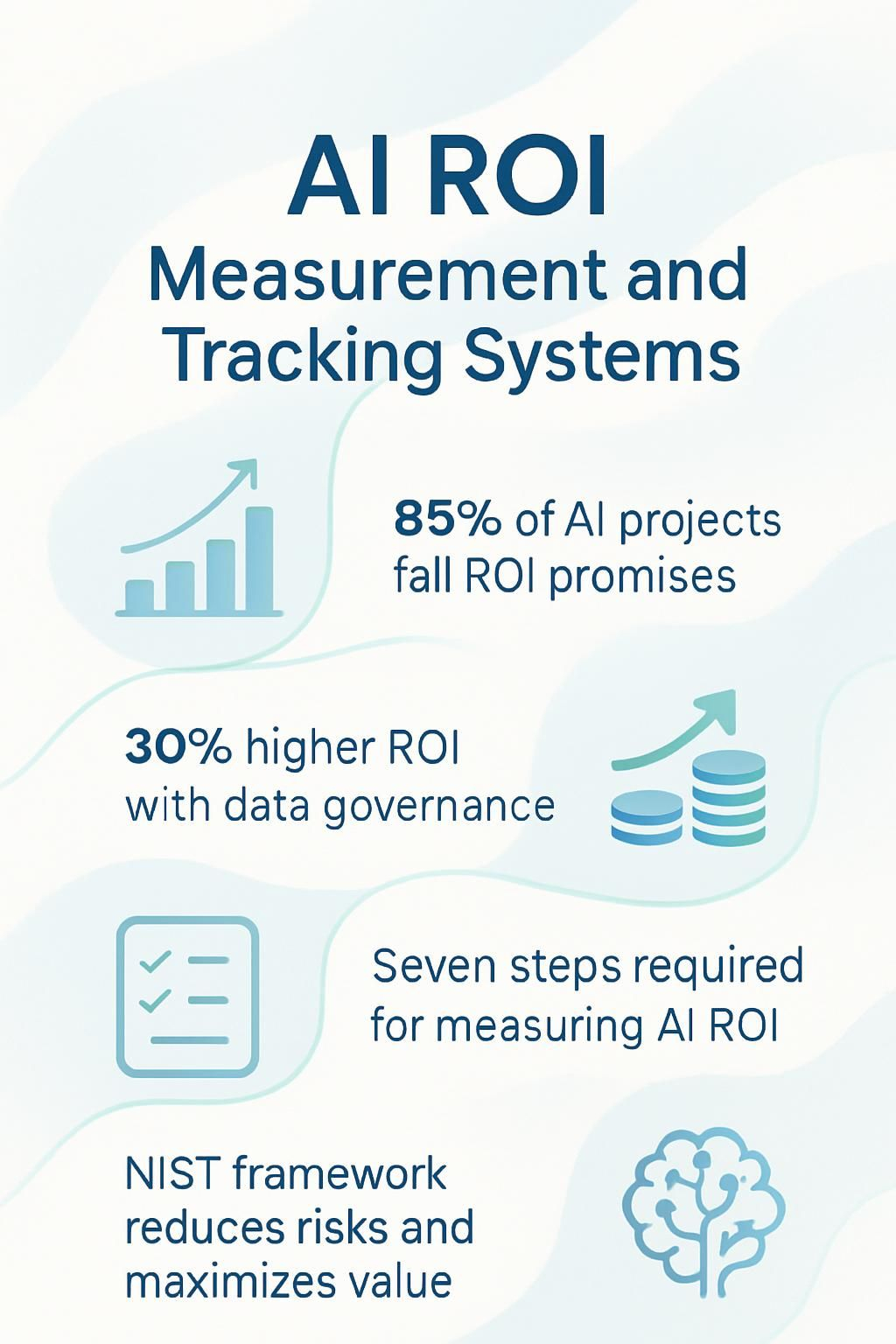AI ROI Measurement and Tracking Systems


Understanding AI Integration

AI ROI measurement tracks how well artificial intelligence investments pay off for businesses. Unlike standard ROI calculations, AI return measurement must capture both obvious benefits like cost savings and hidden values such as better customer experiences.
Many business leaders struggle to prove AI's worth because the gains aren't always clear on spreadsheets.
"I've seen countless companies install fancy AI systems without any plan to measure success," says Reuben "Reu" Smith, founder of WorkflowGuide.com and AI automation strategist who has built over 750 workflows for businesses.
The numbers speak volumes about AI's potential impact. Organizations using AI report a 19.5% increase in sales and an 18.1% rise in employment rates between 2010 and 2018. Real-world examples show impressive results: PayPal's AI risk management cut losses by 11% while driving $7.3 billion in quarterly revenue, and an AI-powered radiology platform achieved up to 791% five-year ROI through workflow improvements.
- PayPal: 11% loss reduction and $7.3 billion in quarterly revenue.
- Radiology platform: Up to 791% ROI over five years.
But measuring these gains requires a structured approach. Companies must define clear goals, establish baselines, and track both direct metrics like revenue growth and indirect benefits like employee efficiency.
The cost of not investing in AI, called Risk Of Non-Investment (RONI), adds another important factor to consider when comparing AI adoption against keeping things the same.
For local business owners and tech-savvy leaders, the challenge lies in creating practical tracking systems that work for their specific needs. This means choosing the right metrics, building dashboards that show real progress, and regularly reviewing results as technology changes.
The payoff for getting this right? Data shows companies with proper AI measurement systems extract significantly more value from their tech investments.
Let's crack the code on AI ROI tracking.
Key Takeaways
- About 85% of AI projects fail to deliver on their investment promises, making proper ROI tracking systems essential for business leaders.
- AI ROI differs from traditional investments because it includes both direct financial gains and harder-to-quantify benefits like improved decision-making quality.
- Companies achieve 30% higher ROI by implementing proper data governance before AI deployment, according to WorkflowGuide.com client data.
- The NIST AI Risk Management Framework offers a structured approach to maximize AI value while reducing potential risks in implementation.
- Successful AI ROI measurement requires seven key steps: defining clear goals, establishing baselines, quantifying all costs, estimating financial gains, measuring intangible benefits, comparing to status quo, and continuous optimization.

Understanding ROI in AI Measurement

AI ROI measurement differs from tracking traditional tech investments because it involves both direct financial gains and improvements such as enhanced decision-making. Companies often stumble when measuring AI returns by focusing only on cost reduction instead of tracking how AI transforms their entire business model.
Defining ROI for AI
ROI for AI represents a financial ratio that compares gains against costs with unique twists. Unlike hardware purchases that depreciate predictably, AI systems improve with data accumulation and require ongoing maintenance.
Think of AI ROI like calculating the value of a smart garden that plants its own seeds and harvests itself but needs regular software updates and occasional expert attention. The formula looks simple (Net Benefit ÷ Total Cost × 100%), but capturing all benefits proves tricky as AI impacts range from direct cost savings to improvements in decision quality.
Data quality directly impacts your AI ROI calculations. Poor training data leads to model degradation over time, affecting long-term performance and investment returns.
Clients at WorkflowGuide.com achieved 30% higher ROI by implementing proper data governance before deployment. The measurement timeframe matters too, as AI projects typically show negative returns initially before reaching profitability while systems learn and improve.
Measuring AI ROI is like trying to weigh smoke with a kitchen scale. The value exists, but traditional tools fail to capture its full essence. Smart leaders create new measurement systems that track both tangible outputs and the previously invisible benefits AI brings to the table. - Reuben Smith, Founder of WorkflowGuide.com
Why Measuring AI ROI is Different from Traditional Investments
Traditional investments follow clear paths. You buy equipment, it produces widgets, you sell widgets, and money rolls in. AI investments differ; benefits spread across your business much like spilled coffee on a keyboard.
Some gains show up instantly with cost savings, while improvements like enhanced customer loyalty take time to appear. Many tech leaders try to apply old ROI formulas to new AI tools, such as measuring water with a ruler.
AI creates both tangible and intangible value that standard ROI calculations miss. A chatbot might reduce support tickets by 30%, yet measuring the benefit of employees tackling complex problems proves challenging. This clarity gap often blocks AI adoption.
The solution requires a structured approach that captures direct financial impacts and the ripple effects throughout the business, much like tracking both the stone thrown into a pond and the waves it creates.
Want To Be In The Inner AI Circle?
We deliver great actionable content in bite sized chunks to your email. No Flim Flam just great content.

Common Pain Points in AI ROI Measurement
Measuring AI ROI feels like trying to count invisible dollars in a dark room. Companies struggle to pinpoint exact benefits while dealing with a maze of metrics that stray from traditional ROI frameworks.
Uncertainty of Benefits
AI investments often leave business leaders questioning actual returns. Unlike traditional tech investments, AI benefits can feel as elusive as trying to catch smoke with your bare hands. Models rarely hit 100% accuracy in real-world applications, creating a foggy picture of true value.
Executives may approve AI projects based on promising demos, only to face declining performance over time without proper maintenance.
The biggest AI ROI challenge isn't implementation, it's quantifying the invisible. We're asking business leaders to measure ghosts with a ruler designed for concrete. - Reuben Smith, AI Strategist
The gap between hard and soft ROI exacerbates this issue. Cost reductions might appear on balance sheets, but improvements in customer experiences or decision-making remain hard to quantify. Data quality issues often further undermine these calculations.
Challenges in Identifying Key Metrics
Pinpointing the right metrics for AI ROI is like trying to hit a moving target while blindfolded. Many business leaders struggle because traditional KPIs do not capture the full impact of AI. One business owner said, "I spent months tracking the wrong numbers." Poor data quality adds to the challenge, with 63% of companies reporting inadequate data for proper measurement.
Metrics must balance short-term gains with long-term transformation potential. A shortage of AI-savvy analysts who understand both technology and business impact further complicates metric selection. Integration challenges also hinder data sharing, leading to incomplete performance pictures and missed chances for optimization.
High upfront costs intensify pressure to show quick wins rather than meaningful progress, skewing metric selection toward immediate results.
Difficulty in Quantifying Intangible Benefits
Measuring intangible benefits from AI investments challenges many tech leaders. Business owners often stare at spreadsheets trying to assign dollar values to "improved customer satisfaction" or "enhanced brand recognition." These benefits dwell in a measurement twilight zone. Data quality problems can sabotage even the best tracking efforts, prompting questions like, "How do I show the board that our chatbot made customers happier?"
Employee well-being improvements may take months or years to reflect in retention numbers. Long timeframes for AI projects add further hurdles for ROI tracking. A machine learning recommendation engine might need 18 months to deliver significant value, while decision-makers often expect quarterly reports.
This pressure can lead to the premature abandonment of promising projects. One AI system appeared to falter at six months but transformed the client's business model by year two. Measuring performance for intangible benefits demands patience and creative approaches that assess organizational impact over appropriate timeframes.
Solutions to Overcome AI ROI Measurement Challenges
Measuring AI ROI does not have to feel like trying to weigh smoke with a kitchen scale. Practical frameworks exist that connect AI projects to business outcomes, turning fuzzy benefits into clear metrics that even finance teams appreciate.
Aligning AI Projects with Business Goals
Business goals must drive AI projects rather than the reverse. Many companies purchase advanced AI tools without a clear plan and later wonder why their ROI is disappointing. Begin by identifying the specific business problem that needs solving—whether that is reducing supply chain costs or boosting sales conversion rates.
According to Frost & Sullivan's 2024 report, 89% of successful AI implementations tied projects directly to core objectives.
Map each AI initiative to revenue growth or cost reduction targets with specific numbers. For example, an HVAC company might deploy AI scheduling to increase daily service calls by 15% or decrease dispatcher workload by 25%.
Pilot testing helps prevent costly mistakes and strengthens internal support. Leaders who test AI solutions in controlled environments before full-scale deployment usually see better results. One retail chain ran a 30-day AI inventory management test in three stores, which allowed the team to fix issues, train staff, and collect real data before scaling. The pilot showed a 12% reduction in stockouts and justified the larger investment. Establish checkpoints to measure progress against initial business goals.
Leveraging Data Quality and Risk Assessment
Aligning with business goals sets the strategic direction, but high-quality data fuels effective ROI metrics. A machine learning model is only as good as the data it consumes. The NIST AI Risk Management Framework offers a structured approach to maximize AI value while minimizing risks.
Data integrity serves as the foundation for accurate ROI calculations. Regular assessments and technological updates create a feedback loop that drives continuous improvement. This approach addresses both performance measurement and risk mitigation.
Ethical AI practices and compliance standards are essential for trustworthy financial impact analysis. A strong governance strategy balances cost-benefit analysis with value measurement techniques.
Iterative Improvement and Adjustments
AI ROI measurement is not a one-time setup. Treat the process like training a digital asset that needs regular evaluations against real-world challenges. Business metrics often change as market conditions shift, rendering old performance benchmarks obsolete.
Smart teams build feedback loops into their AI systems from the start, gathering data on successes and setbacks. Past examples show that without regular reviews, AI projects can drift off course.
Continuous improvement is key. Initial ROI projections may overlook hidden expenses that surface during implementation. One manufacturing client discovered their predictive maintenance AI focused on the wrong equipment failures until adjustments quadrupled their ROI. Establish proper baseline assessments before deployment to track true financial impact.
Steps to Effectively Measure AI ROI
Measuring AI ROI involves a clear process that turns fuzzy benefits into hard numbers. This process connects AI investments to tangible business results, much like tracking how a coffee machine pays for itself through fewer daily outings.
Seven practical steps guide this process:
- Define Clear Goals and KPIs: Establish specific objectives such as reducing support ticket resolution time by 15% or increasing the sales conversion rate by 8%.
- Establish a Baseline for Measurement: Capture current performance metrics in the use cases where AI will operate.
- Quantify Costs: Document all upfront expenses like software licensing and ongoing costs such as maintenance and updates.
- Estimate Revenue Gains and Cost Savings: Map each AI capability to specific monetary outcomes like labor cost reductions or inventory optimization.
- Identify and Measure Intangible Benefits: Track improvements in decision-making efficiency, employee well-being, and customer satisfaction.
- Develop a Status Quo Comparison: Calculate the Risk Of Non-Investment (RONI) by assessing potential losses from maintaining current systems.
- Review, Adjust, and Continuously Optimize: Regularly evaluate and refine AI systems to ensure ongoing alignment with business goals.
These performance measurement steps clarify ROI metrics, supporting effective business outcomes evaluation and investment analysis.
Key Metrics for AI Success Tracking
Tracking the right metrics transforms AI from a mysterious tool into a clear business asset. Both direct financial indicators and indirect benefits play vital roles.
Direct Metrics: Revenue Growth and Cost Reductions
Revenue growth and cost reductions are the twin pillars of AI ROI measurement. These direct metrics provide clear, dollars-and-cents proof that AI investments pay off. For business leaders, tracking revenue increases from AI-powered sales predictions or customer targeting serves as immediate validation.
For example, a chatbot can manage customer inquiries around the clock while automation cuts labor costs. AI tools can significantly reduce inventory costs, such as when AI demand forecasting turns a six-figure investment into substantial annual savings. These metrics support a sound financial impact analysis.
Indirect Metrics: Customer Experience and Employee Efficiency
Indirect metrics reveal AI's broader impact. Customer experience improvements are seen in faster response times and higher satisfaction ratings, while employee efficiency improves when staff focus on higher-value tasks. A chatbot rated 4.8/5 stars that reduces support costs by 30% illustrates how enhanced experiences can drive tangible business benefits.
Such metrics are key to overall business intelligence and aid in predictive analytics ROI evaluation.
Long-Term Metrics: Market Position and Innovation Potential
Market position metrics show whether AI investments help companies outpace competitors. Firms that invest in AI have experienced a 19.5% boost in sales, demonstrating notable revenue growth. Innovation potential metrics assess how AI spurs new ideas, products, and business models.
Monitoring these long-term metrics supports ongoing investment analysis and strengthens a business strategy that embraces progress.
Real-World Case Studies of AI ROI
Three case studies illustrate how organizations have tracked their AI ROI with precision. One healthcare system reduced costs while improving patient outcomes by 23%. A bank prevented $4.2 million in fraud within six months through AI-driven risk management. A retail chain cut supply chain expenses by 18% using AI-powered inventory management. These examples underline the practical value of well-defined ROI metrics.
Case 1: AI in Healthcare Cost Reduction and Patient Outcomes
AI-powered radiology platforms deliver significant returns. One example showed a 451% return over five years, which increased to 791% when radiologist time savings were included. These systems improve diagnostic accuracy while streamlining workflows, achieving dual benefits for hospitals focused on financial impact and patient care.
Case 2: AI-Driven Fraud Prevention in Financial Services
AI plays a key role in fraud prevention. PayPal employs machine learning to detect suspicious patterns that human analysts might miss. Data shows PayPal reported $7.3 billion in revenue for Q2 2023, a 7% year-over-year increase, while AI-driven risk management cut losses by 11%. Rapid model deployment—training to deployment in 2-3 weeks—demonstrates the value of prompt adaptation in financial impact analysis.
Case 3: Retail Chain AI Adoption for Supply Chain Optimization
A major retail chain achieved average monthly cost savings of 5.76% after implementing AI systems. AI tools reduced delivery times by up to 50%, transforming inventory tracking from a manual process into a dynamic system. Enhanced supply chain visibility allowed managers to spot issues before they became costly mistakes. A store manager remarked, "Our AI doesn't sleep, take breaks, or have bad days. It just keeps optimizing." Improved inventory accuracy and operational efficiency reinforced the importance of AI adoption metrics in business outcomes evaluation.
Best Practices for AI ROI Tracking Systems
Setting up tracking systems for AI ROI requires strategic planning. Effective tools capture both quick wins and long-term value that align with specific business goals.
Integrating ROI Tracking Tools with AI Platforms
Connecting ROI tracking tools with AI platforms streamlines performance measurement. When these tools automatically pull data from systems like CRM and financial software, they create a feedback loop that identifies which AI features drive cost savings and revenue growth.
One client set up a dashboard that tracked customer service AI metrics against cost savings daily. This system flagged underperforming components quickly, allowing timely adjustments.
Choosing the Right Metrics for Your Industry
Industry-specific metrics are essential. A manufacturing plant may focus on production efficiency and defect reduction, while a retail store tracks inventory turnover and customer lifetime value. Financial services benefit from monitoring fraud detection rates and processing time improvements.
Select metrics that pass the "so what" test. High-performing companies choose 5-7 key performance indicators that directly impact operational efficiency and customer experience, thereby strengthening their overall business strategy.
Regularly Reviewing and Updating Tracking Systems
AI tracking systems require periodic reviews to remain relevant. Outdated tools may miss current opportunities, much like using obsolete game stats to plan a winning strategy.
Routine reviews, supported by fresh data inputs, ensure accurate financial impact analysis. One client discovered their initial system missed 40% of actual ROI because metrics were not updated for eight months. Consistent refinements help capture complete performance data.
Utilizing AI Performance Dashboard Design Templates
Pre-built dashboard templates can save hours of design work and provide proven layouts for tracking ROI metrics. These templates include drag-and-drop interfaces that allow customization of key indicators such as heat maps, trend lines, and before/after comparisons.
The templates often integrate directly with existing data sources, reducing manual entry and ensuring real-time insights that support effective investment analysis.
Conclusion: Unlocking the Full Value of AI Investments
Tracking AI ROI demands a shift from traditional metrics to comprehensive systems that capture both tangible and intangible benefits. Business leaders understand that well-defined measurement frameworks convert vague AI promises into concrete results. Many companies have invested heavily in AI tools without proper tracking, resulting in missed performance measurement opportunities. AI investments deserve clear KPIs, baseline assessments, and regular reviews to transform tech spending from a cost center into a profit engine.
WorkflowGuide.com can help build custom tracking dashboards that connect AI performance directly to the bottom line. Business leaders may consider identifying one AI initiative in their organization and establishing its baseline metrics before the next quarter, then observe how data transforms investments using ROI metrics and cost-benefit analysis.
For more insights on optimizing your AI projects, visit our guide on AI performance dashboard design templates.
FAQs
1. What are AI ROI Measurement and Tracking Systems?
AI ROI Measurement and Tracking Systems are tools that help companies monitor the financial returns from their artificial intelligence investments. They collect data on AI performance, compare costs against benefits, and generate reports showing if your AI tools are worth the money spent. Think of them as financial scorecards for your AI projects.
2. Why should businesses track AI ROI?
Money talks. Without tracking AI ROI, you are flying blind with tech spending. Companies that measure returns can identify which AI tools boost profits and which ones drain resources.
3. What metrics matter most when measuring AI ROI?
The key metrics include time saved, error reduction, revenue growth, and cost savings. Different AI applications require different yardsticks. For customer service bots, focus on reduced call times and higher satisfaction scores; for production AI, monitor defect rates and output speed.
4. How often should companies evaluate their AI ROI?
Quarterly reviews work best for most AI systems. New implementations might need monthly check-ups at first to catch problems early. Some AI benefits take time to manifest, so give projects sufficient time before drawing conclusions.
Disclosure: This content is for informational purposes only and does not constitute professional financial advice. Data analytics and financial impact analysis are provided as contextual information. WorkflowGuide.com does not guarantee any specific return on investment or cost savings. The content reflects insights based on internal expertise and reliable data sources.
Still Confused
Let's Talk for 30 Minutes
Book a no sales only answers session with a Workflow Guide
References and Citations
References
- https://tech-stack.com/blog/roi-of-ai/ (2024-08-21)
- https://www.sandtech.com/insight/a-practical-guide-to-measuring-ai-roi/ (2025-01-10)
- https://ignitetech.ai/about/blogs/why-measuring-roi-essential-ai-success
- https://papers.ssrn.com/sol3/Delivery.cfm/SSRN_ID3858398_code4292965.pdf?abstractid=3858398&mirid=1
- https://www.tribe.ai/applied-ai/measure-ai-roi (2024-10-17)
- https://www.datacamp.com/blog/roi-of-ai (2024-11-14)
- https://www.neurond.com/blog/ai-roi
- https://www.researchgate.net/publication/389657993_Leveraging_Artificial_Intelligence_AI_Effectively_Managing_Risks_and_Boosting_Productivity
- https://www.forbes.com/councils/forbesbusinesscouncil/2025/05/07/19-ways-to-measure-the-roi-of-your-ai-initiatives/
- https://sparknav.com/insights/4-steps-to-measure-ai-automation-roi/
- https://propeller.com/blog/measuring-ai-roi-how-to-build-an-ai-strategy-that-captures-business-value
- https://www.forbes.com/sites/kolawolesamueladebayo/2025/06/05/ai-roi-isnt-just-dollars-how-to-measure-intangible-wins/
- https://businessanalyticsinstitute.com/the-roi-of-ai-measuring-success-in-ai-projects/
- https://chooseacacia.com/measuring-success-key-metrics-and-kpis-for-ai-initiatives/
- https://www.sciencedirect.com/science/article/pii/S0304405X2300185X
- https://www.linkedin.com/pulse/real-world-case-studies-ai-roi-techstack-limited-8e5zf
- https://eleks.com/research/ai-in-supply-chain/
- https://www.researchgate.net/publication/387667312_Integration_of_Artificial_Intelligence_AI_in_Enterprise_Resource_Planning_ERP_Systems_Opportunities_Challenges_and_Implications (2025-04-11)
- https://www.neurond.com/blog/generative-ai-roi
- https://www.revgenpartners.com/insight-posts/roi-in-ai-a-framework-for-measurement/
- https://agility-at-scale.com/implementing/roi-of-enterprise-ai/
- https://corporatefinanceinstitute.com/resources/data-science/ai-kpis-tracking-performance/



